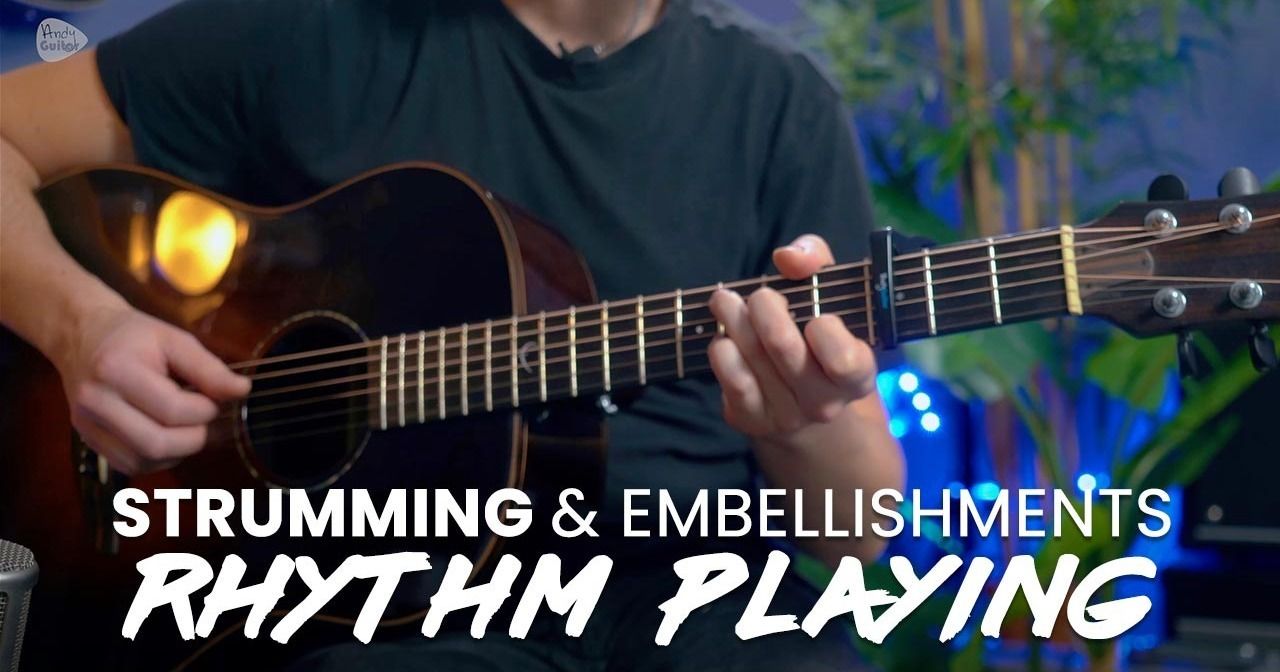In this video
Connect with Andy and other AAA members between live sessions with the Andy Guitar AAA Discord community - the link is on the membership page here.
In this live guitar lesson we look at common strumming embellishments, rhythm exercises and time signatures alongside famous strumming patterns such as the "Boom Chicka" rhythm, made famous by Johnny Cash and Bob Dylan.
Requests
Colin - muted strumming
Rolling in the deep
CCR/ Stuck in the middle
Sotiris - mute by lifting a barre chord (Faith)
Gloria
Faith
Jack Jonson
34, 68, 128 time
Heather - Boom chicka
Johnny Cash
Bob Dylan
Wild wood
Alan Psuedo barre chords - Yellow, Pinball Wizard
Top tips
Can’t get a rhythm?: Clap and count rhythms in different time signatures to internalize the beat.
Off beats: Struggle with more syncopated rhythms with more up strums than down strums? Try doing reggae style off beat only patterns; I’m Yours, Natural Mystic
Don’t strum all the strings all the time: Thicker on the down, thin on the up, accents on 2 and 4
Twist the wrist: Strumming should feel like shaking your hand out as a motion
Muting and dynamics : Strumming sounding stale? Add muting, dynamics and 16th embellishments to give it life!
Section 1: Understanding Time Signatures (10 minutes)
Basics of Time Signatures:
Explain common time signatures: 4/4, 3/4, 6/8 and 12/8
First number is how many, 2nd number is how LONG is the beat (1/4 notes, 8th notes)
4:4 - Chasing Cars, Wonderwall (MOST songs!)
Difference between
3:4 - All from here have a Waltz Time feel, but to be in 3:4, the song should change chord or have a very strong beat on 1 of 3; Mr Bojangles
6:8 - counted as 1-2-3, 1-2-3 with a strong accent on the "1", Hallelujah and House of the Rising Sun
12/8 allows for a lot of rhythmic flexibility and complexity. It’s often used in blues and jazz to provide a smooth, swinging feel that’s much looser than 3/4 or 6/8, offering a laid-back, relaxed groove. 12:8 - 1-&-a, 2-&-a, 3-&-a, 4-&-a, "Gravity" by John Mayer and "Everybody Hurts" by R.E.M - ALSO I’m with you & Lover
Songs in 3/4, 6/8, and 12/8 time signatures might seem similar because they all can be counted with a sort of "waltz" feel, but they differ significantly in how they are phrased, felt, and played.
Mostly on the chord change?
12/8 Time Signature
Structure: Typically, 12/8 is counted as four beats per measure, with each beat divided into three sub-beats (1-&-a, 2-&-a, 3-&-a, 4-&-a). It combines the feel of 4/4 time with the rhythmic subdivision of triplets.
Feel: 12/8 allows for a lot of rhythmic flexibility and complexity. It’s often used in blues and jazz to provide a smooth, swinging feel that’s much looser than 3/4 or 6/8, offering a laid-back, relaxed groove.
Examples: "Gravity" by John Mayer and "Everybody Hurts" by R.E.M.
Comparison and Musical Impact
While 3/4, 6/8, and 12/8 might each have a triplet feel, the way they are counted and where the accents fall make them suitable for different types of music. The choice of time signature affects the overall feel, rhythm, and flow of a song. In composition, choosing between these time signatures depends on the musical context and the emotional effect the composer wants to achieve. Each brings a different type of rhythmic movement and energy, impacting how a piece is perceived and experienced by listeners.
Section 2: Common Strumming Patterns (15 minutes)
Strumming Techniques:
Demonstrate basic strumming patterns: downstrokes, upstrokes, and mixed patterns.
Introduction to 16th-note strumming for more complex rhythms.
Song Example: "Wonderwall" by Oasis – Focus on the distinctive 16th-note strumming pattern.
Section 3: Advanced Strumming Techniques (10 minutes)
Techniques Covered:
Palm Muting: Technique to mute the strings slightly with the palm to produce a softer sound.
Suspended Chords (sus2, sus4): How to use them to add tension and release in rhythm playing.
Song Example: "Every Breath You Take" by The Police – Use of sus chords in the main riff.
Section 4: Embellishments for Rhythm Guitar (10 minutes)
Flourishes and Fills:
Adding small licks and flourishes within a strumming pattern.
Techniques for creating fills between chord changes.
Song Example: "Under the Bridge" by Red Hot Chili Peppers – Incorporating melodic fills in rhythm playing.
Section 5: Genre-Specific Techniques (15 minutes)
Overview of Genres:
Pop: Focus on catchy, straightforward strumming patterns.
Blues: Shuffle rhythms and the use of seventh chords.
Funk: Syncopated strumming and use of muted strums.
Song Examples:
Pop: "I’m With You" by Avril Lavigne – Simple yet effective strumming.
Blues: "Pride and Joy" by Stevie Ray Vaughan – Shuffle rhythm and blues strumming.
Funk: "Get Lucky" by Daft Punk – Tight, muted strumming for a funky feel.
This lesson plan aims to enhance students' rhythmic precision and creative expression on the guitar, broadening their abilities across multiple genres with practical, song-based examples to ensure the techniques are relatable and implementable.
Join me here on the website for weekly live sessions where we can work directly on your playing & give the feedback needed for you to move forward and get inspired!
Every week we cover topics such as;
How to make the most of your practice time
Songs and exercises at your level and based on your music taste
How you can stay motivated and maximise your progress
You can also request a tutorial for a song YOU want to learn and Andy will teach it during the session live! Each live stream is automatically available as a replay so you can catch up anytime and never miss a beat!

